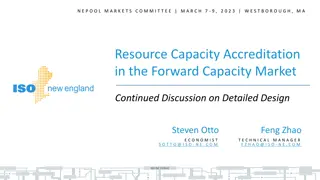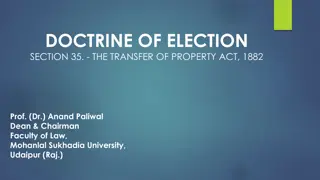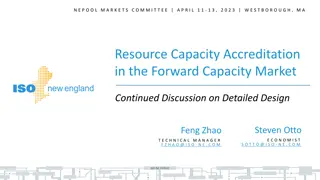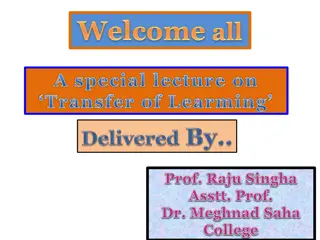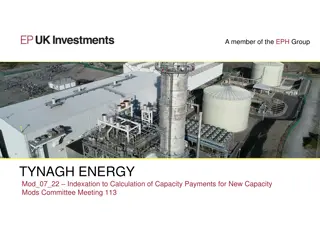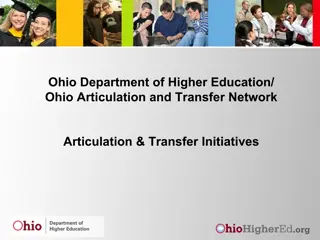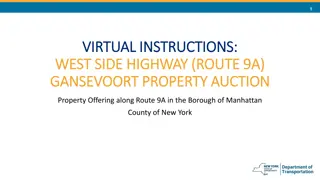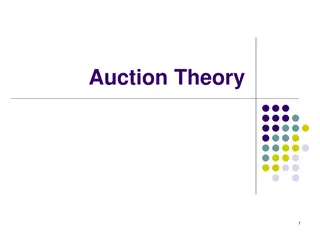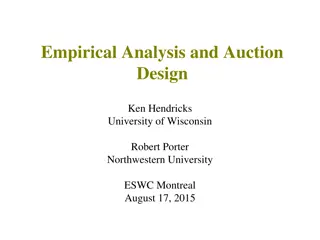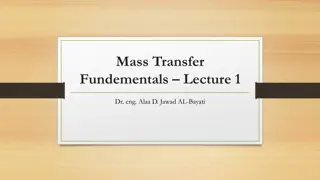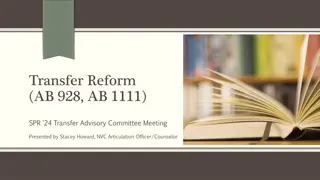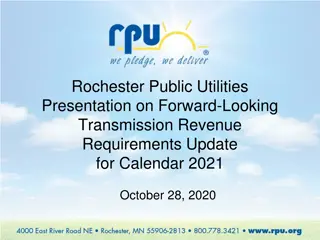Update on Forward Capacity Auction 18 Transmission Transfer Capabilities
This update covers the progress and developments surrounding the Forward Capacity Auction 18 (FCA 18) transmission transfer capabilities, Capacity Zone Development, and ongoing analyses in New England's power system. The ISO-NE has been actively reviewing interface transfer capabilities, discussing Maine interface transfer capabilities, and addressing changes impacting the Boston/Southeast New England import transfer capabilities. Stay informed on the latest infrastructure updates and system constraints to ensure efficient power transfer operations.
Download Presentation

Please find below an Image/Link to download the presentation.
The content on the website is provided AS IS for your information and personal use only. It may not be sold, licensed, or shared on other websites without obtaining consent from the author. Download presentation by click this link. If you encounter any issues during the download, it is possible that the publisher has removed the file from their server.
E N D
Presentation Transcript
M A R C H 1 6 , 2 0 2 3 | W E B E X T E L E C O N F E R E N C E Forward Capacity Auction 18 Transmission Transfer Capabilities & Capacity Zone Development Planning Advisory Committee Alex Rost M A N A G E R , R E S O U R C E Q U A L I F I C A T I O N ISO-NE Public
Topics Review of interface transfer capabilities Proposed Capacity Zone construct for Forward Capacity Auction (FCA) 18, which is associated with the 2027-2028 Capacity Commitment Period (CCP) ISO-NE Public 2
FCA 18 Capacity Zone Development: Steps So Far ISO presented the FCA 18 Capacity Zone Development Preview at the December 2022 Planning Advisory Committee (PAC) meeting ISO presented the 2023 Forward Capacity Market Transmission Certifications at the January 2022 Reliability Committee (RC) meeting ISO-NE Public 3
REVIEW OF INTERFACE TRANSFER CAPABILITIES Internal Interfaces ISO-NE Public ISO-NE Public 4 ISO-NE INTERNAL USE
Update on Review of Maine Interface Transfer Capabilities The ISO informed the PAC during the December 2022 FCA 18 Capacity Zone Development Preview presentation that: It s currently investigating the impacts of changes to NPCC A-10 (Criteria on the Classification of Bulk Power System Elements) on the transfer capabilities of interfaces in ME If completed in time (e.g. around the end of Q1/start of Q2 2023), the ISO will consider the results of this analysis for the FCA 18 Capacity Zone formation process The analysis will not be completed in time for consideration in the FCA 18 Capacity Zone formation process Stability, voltage and thermal analyses to identify key system constraints and evaluate interactions among the Maine interfaces for transfers above the current A-10 limited transfer levels are ongoing Completion of the analysis is expected near the end of 2023 ISO-NE Public 5
A Note on the Boston/Southeast New England (SENE) Import Transfer Capabilities Several system changes have affected the Boston/SENE import transfer capabilities System Change Boston/SENE N-1 Import Transfer Capability (MW) Greater Boston Upgrades, except for the Wakefield-Woburn 345 kV line1 5,400 Updated load assumptions, updated Northern New England (NNE)- Scobie transfer capability and retirement of Mystic 7, 8 & 9, and with the Boston Area Optimized Solution 2 5,250 1. Wakefield-Woburn 345 kV line is a portion of the Greater Boston Upgrades. The in-service date has been updated to December 2023. 2. Accounts for all of the Greater Boston Upgrades, including the Wakefield-Woburn 345 kV line ISO-NE Public 6
A Note on the Boston/SENE Import Transfer Capabilities, cont d Several system changes have affected the Boston/SENE import transfer capabilities System Change Boston/SENE N-1-1 Import Transfer Capability (MW) Boston Area Optimized Solution1 4,550 Opening of the K Street Breaker 4,850 1. Accounts for all of the Greater Boston Upgrades and the retirement of the Mystic units ISO-NE Public 7
FCA 18 Internal Interface Transfer Capabilities (MW) Single-Value, Summer Peak,Non-Firm, Transmission Interface Limits for Use in Subarea Transportation Models a Interface Orrington-South Surowiec-South Maine-New Hampshire Northern New England-Scobie + 394 North-South 2023 1325 1500 1900 3450 2725 2024 1325 1500 1900 3450 2725 2025 1325 1500 1900 3450 2725 2026 1325 1500 1900 3450 2725 2027 1325 1500 1900 3450 2725 2028 1325 1500 1900 3450 2725 2029 1325 1500 1900 3450 2725 2030 1325 1500 1900 3450 2725 2031 1325 1500 1900 3450 2725 2032 1325 1500 1900 3450 2725 3400c 3000 5400 4500 3400 1800 800 5400 4500 East-West West-East Boston Import (N-1) Boston Import (N-1-1) SEMA/RI Export SEMA/RI Import (N-1) SEMA/RI Import (N-1-1) Southeast New England Import (N-1) Southeast New England Import (N-1-1) 3400 3000 5250b 4850b 3400 1800 800 5250b 4850b 3400 3000 5250 4850 3400 1800 800 5250 4850 3400 3000 5250 4850 3400 1800 800 5250 4850 3400 3000 5250 4850 3400 1800 800 5250 4850 3400 3000 5250 4850 3400 1800 800 5250 4850 3400 3000 5250 4850 3400 1800 800 5250 4850 3400 3000 5250 4850 3400 1800 800 5250 4850 3400 3000 5250 4850 3400 1800 800 5250 4850 3400 3000 5250 4850 3400 1800 800 5250 4850 Connecticut Import (N-1) Connecticut Import (N-1-1) SW Connecticut Import (N-1) SW Connecticut Import (N-1-1) 3400 2200 2800 1900 3400 2200 2800 1900 3400 2200 2800 1900 3400 2200 2800 1900 3400 2200 2800 1900 3400 2200 2800 1900 3400 2200 2800 1900 3400 2200 2800 1900 3400 2200 2800 1900 3400 2200 2800 1900 Notes are discussed on the following page ISO-NE Public 8
FCA 18 Internal Interface Transfer Capabilities (Notes) a) Limits are for the summer period, except where noted to be winter The limits may not include possible simultaneous impacts, and should not be considered as firm For the years within the Forward Capacity Market (FCM) horizon (CCP 2027-2028 and sooner), only accepted certified transmission projects are included when identifying transfer limits For the years beyond the FCM horizon (CCP 2028-2029 and later), proposed plan approved transmission upgrades are included according to their expected in-service dates b) The transfer capability was decreased by updated load assumptions, updated Northern New England (NNE)-Scobie transfer capability and retirement of Mystic 7, 8 & 9, and increased by the completion of the Greater Boston upgrades (including the Wakefield Woburn 345 kV line) and the Boston Area Optimized Solution, and increased by the inclusion of the opening of the K Street breaker for only the N-1-1 transfer capability c) The East-West interface transfer capability has not changed; the value presented in the table is its margined limit, where the 3,500 MW value presented in earlier versions of this table is its unmargined limit ISO-NE Public 9
REVIEW OF INTERFACE TRANSFER CAPABILITIES External Interfaces ISO-NE Public ISO-NE Public 10 ISO-NE INTERNAL USE
FCA 18 External Interface Import Capability (MW) Single-Value, Summer Peak,Non-Firm, Transmission Interface Limits for Use in Subarea Transportation Models 1 Interface New Brunswick-New England (energy import capability)2 New Brunswick-New England (capacity import capability)2 2023 2024 2025 2026 2027 2028 2029 2030 2031 2032 1000 1000 1000 1000 1000 1000 1000 1000 1000 1000 700 700 700 700 700 700 700 700 700 700 HQ-New England (Highgate) (energy import capability)3 HQ-New England (Highgate) (capacity import capability) 217 217 217 217 217 217 217 217 217 217 200 200 200 200 200 200 200 200 200 200 HQ-New England (Phase II) (energy import capability)4 HQ-New England (Phase II) (capacity import capability) 2000 2000 2000 2000 2000 2000 2000 2000 2000 2000 1400 1400 1400 1400 1400 1400 1400 1400 1400 1400 Cross-Sound Cable (CSC) (energy import capability)5 Cross-Sound Cable (CSC) (capacity import capability) 330 330 330 330 330 330 330 330 330 330 0 0 0 0 0 0 0 0 0 0 New York-New England (energy import capability)6 New York-New England (capacity import capability) 1400 1400 1400 1400 1400 1400 1400 1400 1400 1400 1400 1400 1400 1400 1400 1400 1400 1400 1400 1400 Notes are discussed on the following pages ISO-NE Public 11
Notes on External Interface Import Capability 1. Limits are for the summer period The limits may not include possible simultaneous impacts, and should not be considered as firm (the bases for these limits are subject to more detailed review in the future) 2. The limit on scheduled energy transactions over the New Brunswick (NB)-New England (NE) Tie is 1,000 MW Historically, when adjusted for the ability to deliver capacity to the greater New England Control area, the NB-NE capacity import capability is 700 MW This is because of downstream constraints; in particular Orrington-South 3. The capability for the Highgate facility is listed at the New England AC side of the Highgate terminal ISO-NE Public 12
Notes on External Interface Import Capability, contd 4. The Hydro-Quebec Phase II interconnection is a DC tie with equipment ratings of 2,000 MW. Due to the need to protect for the loss of this line at full import level in the PJM and New York (NY) Control Areas systems, ISO-NE has assumed its transfer capability for capacity and reliability calculation purposes to be 1,400 MW This assumption is based on the results of loss-of-source analyses conducted by PJM and NYISO 5. Import capability on the Cross Sound Cable (CSC) is dependent on the level of local generation 6. NY interface limits These are without CSC and with the Northport Norwalk Cable at 0 MW flow Simultaneously importing into NE and SWCT or Connecticut can lower the NY-NE capability (very rough decrease = 200 MW) ISO-NE Public 13
PROPOSED POTENTIAL ZONAL CONSTRUCT FOR FCA 18 ISO-NE Public ISO-NE Public 14 ISO-NE INTERNAL USE
Proposed Potential Zonal Construct for FCA 18 For FCA 18, the following potential zones (unchanged from the potential zones evaluated for FCA 17) will be evaluated using the Capacity Zone modeling objective criteria triggers in Section III.12.4 of the Tariff Potential export-constrained zones: Northern New England ( NNE - Vermont, New Hampshire & Maine) Maine nested within NNE Potential import-constrained zones: Southern New England ( SENE - Northeast Massachusetts/Boston & SEMA/RI) Connecticut Pursuant to Section III.12.4 (b) of the Tariff, the ISO must model out-of- service all Retirement De-List Bids and Permanent De-List Bids (including any received for the current FCA at the time of the calculation) The window for submitting these bids for FCA 18 is March 30 April 6, 2023 Submissions are based on the FCA Starting Price (which is dependent on the Cost of New Entry (CONE)) and the Capacity Performance Payment Rate (CPPR) ISO-NE Public 15
Potential Capacity Zone Construct for FCA 18 Note: Supply from New Brunswick is modeled as connected to Maine Maine NNE Rest-of-Pool (West Central Mass, NY-AC & Phase II) SENE (NEMA/ Boston & SEMA/RI) Connecticut Note that zones are modeled in the FCA only if the objective criteria in Section III.12 of the Tariff is triggered ISO-NE Public 16
Interface Transfer Capabilities for Potential Capacity Zone Boundaries FCA 17 Transfer Capabilities (MW) FCA 18 Transfer Capabilities (MW) SENE Import N-1 5,250 SENE Import N-1 5,250 SENE Import N-1-1 4,850 SENE Import N-1-1 4,850 Connecticut Import N-1 3,400 Connecticut Import N-1 3,400 Connecticut Import N-1-1 2,200 Connecticut Import N-1-1 2,200 North-South (NNE Boundary) N-1 2,725 North-South (NNE Boundary) N-1 2,725 Maine-New Hampshire (Maine Boundary) N-1 1,900 Maine-New Hampshire (Maine Boundary) N-1 1,900 ISO-NE Public 17
A Note on Dispatch Zones (Active Demand Capacity Resources) Tariff Section III.12.4A. Dispatch Zones The ISO shall establish Dispatch Zones that reflect potential transmission constraints within a Load Zone that are expected to exist during each Capacity Commitment Period. Dispatch Zones shall be used to establish the geographic location of Active Demand Capacity Resources. For each Capacity Commitment Period, the ISO shall establish and publish Dispatch Zones by the beginning of the New Capacity Show of Interest Submission Window of the applicable Forward Capacity Auction, and those Dispatch Zones shall remain in place through the end of the Capacity Commitment Period for which they were established. The ISO will review proposed Dispatch Zones with Market Participants prior to establishing and publishing final Dispatch Zones. The ISO is proposing no changes to the existing Dispatch Zones ISO-NE Public 18
Next Steps The potential Capacity Zone boundaries will be tested using the Step 2 objective criteria trigger calculations Results scheduled to be presented at the May 31, 2023 Power Supply Planning Committee Zones that trigger the objective criteria will be modeled in FCA 18 and associated reconfiguration auctions Whether any of the modeled zones bind in FCA 18 and experience price-separation will be determined during the auction itself ISO-NE Public 19
APPENDIX Methodology for Modeling Capacity Zones in FCM ISO-NE Public ISO-NE Public ISO-NE INTERNAL USE
Developing Zonal Boundaries for the FCM Included in section 14 of Attachment K of the ISO New England Open Access Transmission Tariff (OATT):* Annual assessment of transmission transfer capability Each year, the ISO shall issue the results of the annual assessment of transmission transfer capability, conducted pursuant to applicable NERC, NPCC and ISO New England standards and criteria and the identification of potential future transmission system weaknesses and limiting facilities that could impact the transmission system s ability to reliably transfer energy in the planning horizon. Each annual assessment will identify those portions of the New England system, along with the associated interface boundaries, that should be considered in the assessment of Capacity Zones to be modeled in the FCM pursuant to ISO Tariff Section III.12. * The OATT is Section II of the ISO Tariff ISO-NE Public 22
Zone Formation: A Two Step Process Step ONE Step TWO Identify the potential zonal boundaries and associated transfer limits to be tested for modeling in the FCM Use objective criteria* to conduct the test determining whether or not the zone meets the trigger to be modeled for the CCP Import-constrained zone Trigger to model the zone is based on the quantity of surplus resources in the zone above the zonal requirement Export-constrained zone Trigger to model the zone is based on the quantity of existing and proposed new resources compared with the maximum capacity capability in the zone Adjacent load zones that aren t import- or export-constrained are modeled together in the rest-of-pool zone *Objective criteria are contained in Section III.12.4 of the ISO Tariff ISO-NE Public 23
Zonal Modeling Timeline Transmission Certifications Pursuant to Attachment K: Conduct transfer analysis Identify zones & boundaries to be evaluated in FCM preparation Discuss with PAC Present to RC Preview boundary expectations for upcoming FCA cycle File new Capacity Zone boundary at FERC if proposed Pursuant to Tariff Section III.12: Calculate whether the zones identified pursuant to Attachment K should be modeled using the objective criteria Develop Installed Capacity Requirement, Local Sourcing Requirement, Maximum Capacity Limit, tie benefits and demand curves Discuss with Power Supply Planning Committee Present to RC for vote Retirement / Permanent De-List Bids that are received in this timeframe would be captured in the zone-modeling calculations File modeled Capacity Zones at FERC as part of the FCA informational filing SOI for FCA FCA Nov Dec Jan Feb Mar Apr May Jun Jul Aug Sep Oct Nov Dec Jan Feb ISO-NE Public 24
External Import Capability Determinations For Use in FCM (Tariff Section III.12.9.2.4) The import capability of all external interconnections with New England will be determined using studies of system conditions expected during the CCP: Forecast 90/10 peak load Existing Generating Capacity Resources at their Capacity Network Resource (CNR) Capability Existing Demand Resources reflecting their Capacity Supply Obligations Stressed Transfers The system will be modeled in a manner that reflects the design of the interconnection If an interconnection and its supporting system upgrades were designed to provide incremental capacity into the New England Control Area, simulations will assume imports up to the level that the interconnection was designed to support If the interconnection was not designed to be comparably integrated, simulations will determine the amount of power that can be delivered into New England over the interconnection ISO-NE Public 25











